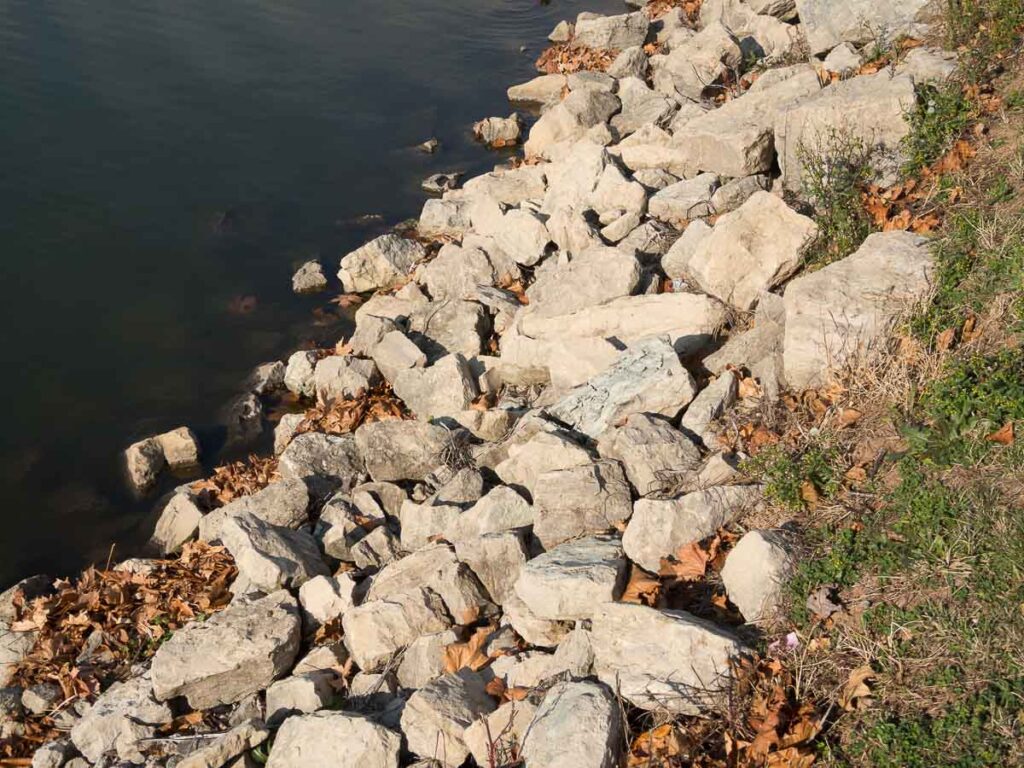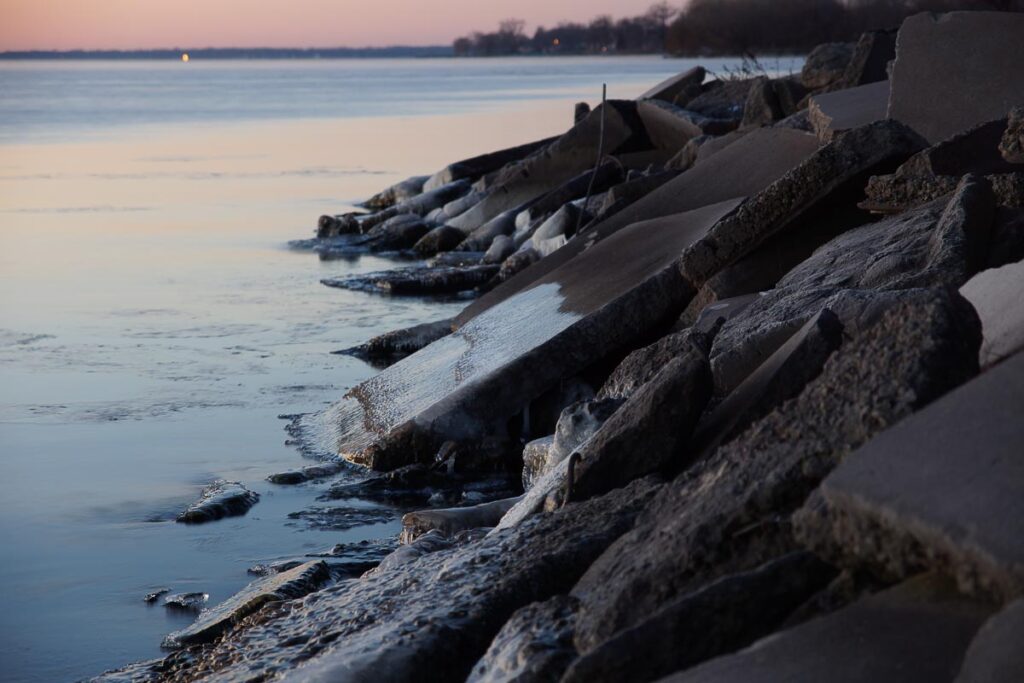Alternative spellings and terms: rip rap, rip-rap, rock armor
You often see the shores of lakes, ponds, rivers, and other waterbodies lined with piles of rock to prevent erosion, protection for manmade structures, or just to give some sense of order to a shoreline. These rocks are called riprap. Rocks are stronger than soil or sand, reducing erosion from waves and ice, but they come with many problems. Although in landscaping, riprap is usually composed of locally available rock, it can be specially formed concrete or broken up concrete, bricks, or other debris from demolition.

Benefits of Riprap
Not all is bad when it comes to riprap. In very high-energy situations, it reduces the erosion of shorelines. This reduces sediment and nutrients that enter the surface water. When in the water, these pollutants would block light, smother plants and animals, and fuel algae blooms.
While rip-rap can be a deathtrap for some animals, the spaces in the rocks can provide some hiding places for frogs and small mammals. In the water riprap, it can provide a unique habitat for insects, crayfish, and other invertebrates.
Habitat can also be protected with the aid of riprap. In my area, the Lake Winnebago system has seen catastrophic sedge meadow wetland loss due to high water levels from dam construction. Over 10,000 acres of floating wetland mats have ripped out and floated into open water where it disintegrates. Lining the wetland with rock armor has stopped this type of erosion, but also prevents the natural interaction between wetland and lake. Still, it is much better to have wetlands than shallow, turbid open water that has largely replaced them.
Riprap is preferable to seawalls. As their name implies, a seawall is a vertical or near-vertical hard structure on a lake or river’s shore. Seawalls are constructed of concrete, stone, metal, or wood. Seawalls offer the ultimate in shoreline protection, but they also direct the power of the waves back into the lake where they can erode the bottom sediments. Seawalls prevent turtles, frogs, muskrats, ducklings, and other critters from getting out of the lake, and can be detrimental to wildlife populations. Seawalls also provide no places for young fish and invertebrates to hide.
Negative Aspects of Riprap
Riprap has many negative attributes deriving from the fact that it is just plain unnatural. Rocky shorelines do occur in nature, but soil and the roots of the lakeshore vegetation are usually intertwined with the rocks. The gaps between rocks in riprap can permanently trap turtles, particularly hatchling turtles, as they move from nest to water. Riprap creates a barren landscape at shorelines that would otherwise be well-vegetated. This natural vegetation is often enough to prevent most erosion, while at the same time providing valuable habitat for many species of wildlife.
Overuse of riprap also increases the channelization of rivers and prevents the formation of unique habitats such as oxbow lakes and ponds. Rivers are meant to wander! The high piles of rock can prevent floodwaters from flowing from rivers into adjacent wetlands that help store the excess water. The same flooded wetlands are visited by fish, such as Northern Pike, which spawn there. Riprap can prevent the migration of these spawning fish.
Whether the installation of riprap is necessary or not, it can be improved to lessen its negative impacts. The easiest way to lessen the impact is to use smaller rocks to fill the gaps between the large ones where turtles can become trapped. Planting native plants or allowing the riprap to become colonized with native vegetation wipes out many of the negative impacts.
Riprap Maintenance
Like any manmade structure, riprap requires maintenance. The heavy rocks can sink into the soft sediments in the water or the water-soaked shoreline soils. Ice, waves, and plain old gravity will pull the rocks into the lake or river over time. Local governments and natural resource agencies may look at this movement as filling in a water body and may require the landowner to remove and re-pile the riprap to its original location. Placement and movement of riprap during maintenance are regulated by state and federal statutes in many situations.
Conclusion
In many situations, riprap is helpful or even necessary, but far too often, it is installed because people think they need it or because it just looks nice. It is difficult to change the minds of those who like the order and simplicity of manicured lawns and squared-off properties. Only those with a keen interest in nature may come over to the disordered beauty of natural shorelines.

Other
Riprap can be interesting too. In my hometown of Oshkosh, Wisconsin, the lumber mills that formed the early industry of this city are long gone, but many of the foundations of those mills are broken and dumped along the edge of the Fox River and Lake Winnebago, where they protect the shore from wave and ice erosion. In some cases, the concrete contains the remains of even older industries. I once found a broken marble sink that was thrown into the concrete when it was formed. Our riprap contains evidence that our society even throws away its industry, but now I’m going off on a tangent.
